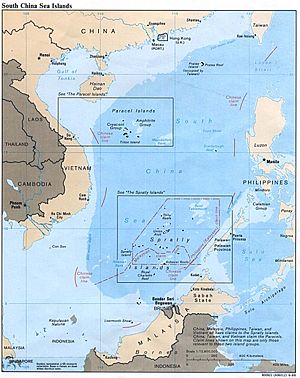South China Sea
The South China Sea is a part of the Pacific Ocean bordered by Singapore and the Strait of Malacca in the southwest, to the Strait of Taiwan in the northeast, and connects to the Gulf of Thailand. Nations on its coasts include Brunei, China, Indonesia, Malaysia, the Philippines, Singapore, and Vietnam.
Chinese Hainan Island is the largest land mass, but the Sea surrounds in excess of 200 small islands, rocks, and reefs, with the majority located in the Paracel and Spratly Islands chains. The small islands are important, however, for political and economic reasons, such as offshore petroleum resources.
Agreements
In 2002, the Association of South East Asian States (ASEAN) and the People's Republic of China adopted the Declaration on the Conduct of Parties in the South China Sea, which agrees to the principles of freedom of sea and air navigation, while recognizing there are sovereignty and resource disputes. [1] Basic principles to guide conduct include:
- The Charter of the United Nations
- the 1982 UN Convention on the Law of the Sea
- the Treaty of Amity and Cooperation in Southeast Asia
- the Five Principles of Peaceful Coexistence,
and other principles of generally accepted international law. The latter two are ASEAN agreements.
In March 2005, the national oil companies of China, the Philippines, and Vietnam signed a joint accord to conduct marine seismic activities in the Spratly Islands Work toward a more binding code of conduct will continue, but, until then, the parties agree to:
- holding dialogues and exchange of views as appropriate between their defense and military officials;
- ensuring just and humane treatment of all persons who are either in danger or in distress (see Safety of Life at Sea convention;
- notifying, on a voluntary basis, other Parties concerned of any impending joint/combined military exercise;
- exchanging, on a voluntary basis, relevant information.
Cooperative efforts can deal with
- marine environmental protection;
- marine scientific research;
- safety of navigation and communication at sea;
- search and rescue operation; and
- combating transnational crime, including but not limited to trafficking in illicit drugs, piracy and armed robbery at sea, and illegal traffic in arms.
Paracel Islands
The Paracels have more economic and strategic activity than the Spratly chain, which are claimed by both China and Vietnam. They include productive commercial fisheries and, and there are likely petroleum reservess. [2]
In 1932, French Indochina annexed the islands and set up a weather station on Pattle Island; maintenance was continued by its successor, Vietnam.
China has occupied the Paracel Islands since 1974, when its troops seized a South Vietnamese garrison occupying the western islands. China built a military installation on Mischief Reef in 1999.
Spratly Islands
China, Taiwan, and Vietnam all claim the entire set of islands, with partial claims Malaysia and the Philippines. About 45 islands are occupied by relatively small numbers of military forces from China, Malaysia, the Philippines, Taiwan, and Vietnam. Brunei has established a fishing zone that overlaps a southern reef but has not made any formal claim.[3]
References
- ↑ ASEAN and the People's Republic of China (November 4, 2002), Declaration on the Conduct of Parties in the South China Sea
- ↑ Central Intelligence Agency, Paracel Islands, The World Factbook
- ↑ Central Intelligence Agency, Spratly Islands, The World Factbook

